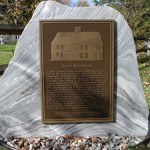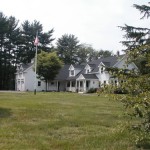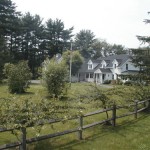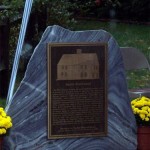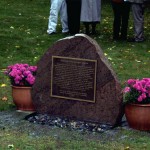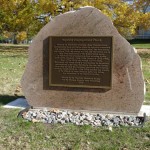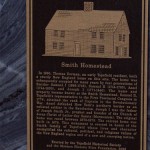Historic Markers in Topsfield, Massachusetts (2005)
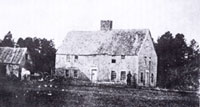
Photo Courtesy: Alexander L. Baugh.
The Mormon Historic Sites Foundation worked with the Topsfield Historical Society to erect a marker at the Smith Family Homestead and at the Congregational Church. The Smith Homestead was the home of five generations of the Smith family and was the birthplace of Joseph Smith, Sr. father of the Prophet Joseph Smith. The Prophet’s ancestors, including Samuel Smith, Asael Smith, and Joseph Smith, Sr. were baptized into the Congregational Church.
Professor Joseph Fielding McConkie, a descendant of Joseph Smith, Sr., spoke the night before the dedication and a portion of the Boston Institute Choir performed.
The verbiage of the marker at the Smith Family Homestead reads as follows:
Smith Homestead
In 1690, Thomas Dorman an early Topsfield resident, built a sturdy New England home on this site. The home was subsequently occupied for many years by four generations of Smiths Samuel I (1666-1748), Samuel II (1714-1785), Asael (1744-1830), and Joseph I (1771-1840). The home and property became known as the Smith Homestead. Samuel II, Topsfield’s representative to the First Provincial Congress in 1774, attained the rank of captain in the Revolutionary War. Asael defended New York’s northern frontier as an enlisted soldier in the Revolution. Joseph I was the father of Joseph Smith Jr., prophet and founder of The Church of Jesus Christ of Latter-day Saints (Mormonism). The original home was razed between 1870-75. The current home was built in 1876.
This monument is erected in honor of the Smith family of Topsfield whose lives exemplified the political and religious values of a new and emerging nation.
Erected by the Topsfield Historical Society and the Mormon Historic Sites Foundation, 2005.
The verbiage of the marker at the Congregational Church reads as follows:
Topsfield Congregational Church
Situated on Topsfield’s Common, three Congregational meetinghouses have provided a place for spiritual communion and worship for over three-hundred years. The first church was built in 1703, the second in 1759, and the present one in 1842.
Five generations of the Robert Smith family of Topsfield were Congregationalists, including: Robert (1626-1693), Samuel I (1666-1748), Samuel II (1714-1785), Asael (1744-1830), and Joseph I (1771-1840). Both Asael and Joseph Smith I were baptized in the second meetinghouse. Like many families in the area, the Smiths were noted for their Revolutionary patriotism and religious devotion. Joseph Smith Jr. (1805-1844), prophet and founder of The Church of Jesus Christ of Latter-day Saints, is a descendant of the Topsfield Smiths.
Erected by the Topsfield Historical Society and the Mormon Historic Sites Foundation, 2005.
Photos
Articles & Resources
Smith homestead
Published in: LDS Church News
Publication Date: October 22, 2005
Published October 22, 2005. Reprinted with permission from the Church News published by the Deseret Morning News.
Smith homestead
Plaques mark early home of Prophet’s ancestors
TOPSFIELD, MASS.
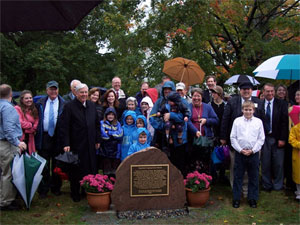
Courtesy Jonathan Wisco
Five generations of the progenitors of the Prophet Joseph Smith in this New England town now have two markers honoring their legacy, thanks to a partnership between the Topsfield Historical Society, the Mormon Historic Sites Foundation and the local Exeter New Hampshire Stake.
Elder M. Russell Ballard of the Quorum of the Twelve, himself a Smith descendant through the Prophet’s brother, Hyrum, dedicated a monument Oct. 15 at 22 Boardman Lane, site of the Smith family homestead. Earlier in the day, Bishop Rob Fitzgerald of the Georgetown Ward dedicated a marker at the Congregational Church in Topsfield, where the five generations of Smiths had worshipped.
In remarks, Elder Ballard expressed appreciation to the historical society, the foundation, and the Friends of the Congregational Church for jointly working together to bring about a significant remembrance of the Smith Family.
Norm Isler, president of the historical society, said his interest in the Smith sites was piqued some years ago when Latter-day Saint visitors to Topsfield would stop by the society inquiring about the location of the homestead. That prompted him to examine the society’s historical records. “A rich history of generations of Smiths living there was disclosed,” he said, “starting with Robert (1666-93), who emigrated from England in 1683, and ending with Joseph’s father, Joseph I (1771-1840).
Mr. Isler contacted the Church, offering to facilitate the placement of a marker by making arrangements with the landowner and the various town boards. “But nothing came of it until this year,” he said.
Karen Bateman, a Church member from Idaho Falls, Idaho, contacted the society to request ancestral information. Learning of Mr. Isler’s interest in placing a marker, she put him in touch with Fred E. Woods, BYU professor of Church history and executive director of the Mormon Historic Sites Foundation.
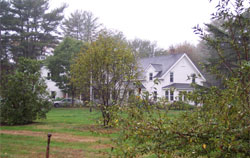
Courtesy Jonathan Wisco
Landowners Brian and Kathy Rossano were enthusiastic about the placement of a marker, Mr. Isler said. Support and approvals were obtained from the town’s Historic Commission, Congregational Church directors, the Park and Cemetery Department, and other bodies. With local contractors and suppliers donating services and products, the stage was set for placement of the markers. Elder Ballard dedicated the monument on the Rossano property, which sits in a significant position at the entrance of the driveway to into their home and farm. With great interest, Mr. Rossano showed family members the original well used by Asael Smith and his son Joseph Smith Sr.
The night before the dedications, a gathering was held in the Coolidge Hall of the Topsfield Fairgrounds, where the New England Latter-day Saints Choir performed and Joseph Fielding McConkie, BYU professor, spoke on “The Early Smiths in Topsfield.” Brother McConkie, the son of Elder Bruce R. McConkie, former member of the Quorum of the Twelve, is a grandson of President Joseph Fielding Smith, who in turn was a grandson of Hyrum Smith.
“In honoring the Smiths, it seems to me that we honor the common man,” Brother McConkie remarked. Then he added, “Yet somehow, by a divine covenant that we will understand only in a future world, we are bound to them and them to us. They, and the many that they represent in the ‘commonness,’ moved the rocks and first plowed the ground. They planted the seeds of liberty that we might feast on its fruits, and taught us how to protect the same with fences built of honor and virtue.
Markers to honor church's heritage
Author(s): John Laidler
Published in: The Boston Globe
Publication Date: June 19, 2005
Published June 19, 2005. Reprinted with permission from The Boston Globe.
Markers to honor church’s heritage
John Laidler, Globe Correspondent, The Boston Globe

Courtesy Alvin Gittins, Intellectual Reserve, Inc.
It is a town with a rich history and a keen interest in preserving it. But at least one strand of Topsfield’s past has remained largely obscure.
Five generations of ancestors of Joseph Smith, Jr. the founder of the Mormon church, resided in Topsfield.
Now, even as the church celebrates the bicentennial of Smith’s birth, a project is underway in Topsfield that promises to bring more awareness of his family’s historic connection with the town.
The Topsfield Historical Society and the Mormon Historic Sites Foundation are collaborating to place two historic markers in town this fall recalling Smith and his familial roots. The Utah-based foundation is a nonprofit that helps identify, preserve, and commemorate sites of significance to Mormon History.
One of the stones will be located in front of a home on Boardman Lane that was previously the site of the Smith family homestead. The other will be placed behind the Congregational Church of Topsfield. The Smith family belonged to the Topsfield church, which has had three buildings on that site over the years.
Historical Society president Norman Isler said the project is important to the town and to the Mormon church – known formally as The Church of Jesus Christ of Latter-day Saints – though for different reasons.
“I’m looking at the whole thing from an historical viewpoint; the Mormons are looking at it I’m sure from the religious standpoint. But we have common objectives here,” he said.
The first Icelandic settlers’ conversion and subsequent migration to America cannot be separated, he said. It also launched a general migration of Icelanders to North America during the rough financial climate in Iceland at the time.
In addition to being ancestors of a historical figure in American religion, “the Smiths were very patriotic and very religious people, and they form a part of the fabric of the early settlers of this town,” Isler said.
Joseph Smith, Jr. did not actually live in Topsfield. He was born in 1805 in Sharon, Vt., where his father, Joseph Smith Sr., had moved from Topsfield. In 1830, Joseph Jr. organized the Mormon church. He and his brother died at the hands of a mob in Illinois in 1844.
But “the fact that four generations of Smiths actually lived on the Boardman Lane site makes it very significant for the Latter-day Saints,” said Fred E. Woods, executive director of the Mormon Historic Sites Foundation, and professor of church history and doctrine at Brigham Young University in Provo, Utah.
The congregational church site was important, too, he added, because of the Smiths’ century-long involvement in that church.
Mormons “by the thousands have gone by this house and gone by the church and there hasn’t been a marker before,” he said.
Praising Topsfield for its cooperation, Woods said, “It’s just a wonderful thing where we can work across the country to do these things.”
Brian Rossano, who with his wife, Catherine, owns the Boardman Lane house, said his family has grown accustomed to seeing Mormon sightseers pull up outside his home to catch a glimpse of the old Smith property. The original Smith house was razed in the 1870s, replaced in 1876 by the Rossanos’ current house. He said his family is glad to accommodate those visitors and to allow the placement of the marker.
“We live on a property that is important to a lot of different people,” he said. “It’s very nice to be part of it and we are happy to let people experience it as part of their history.
The Rev. Norman Bendroth, interim pastor of the Congregational Church of Topsfield, said, “Even though historically, religiously, spiritually we are a totally different lineage [than the Mormons], it’s still of historic significance so we certainly want to honor and participate in that,” he said.
The society and the foundation plan ceremonies on Oct. 15 when the markers will be installed. The preceding evening, they will sponsor a presentation by a Mormon choir and a talk by Joseph McConkie, a BYU professor and the great-great-great grandson of Joseph Smith Sr., regarding the church’s connection to Topsfield.
Isler became aware of the town’s Mormon connection about a decade ago when some Mormon visitors stopped into the Historical Society’s Parson Capen House and inquired where the Smith homestead was. Isler told them he did not know. But soon after, through research, he learned about the Smith family, including that several of its members are buried at the town’s Pine Grove cemetary.
According to Mormon history accounts and Topsfield Historical Society records, Robert Smith came from England to Boston in 1638, later settling in Topsfield. His son, Samuel Smith, born in 1666, was the first of the Smiths to occupy the original homestead on Boardman Lane, built in 1690.
His son, Samuel Smith, Jr. born in 1714, was a community leader and a fervent supporter of American independence. A selectman and state legislator, he represented the town at the First Provincial Congress in Massachusetts in 1774, and was a captain in the Continental Army during the Revolutionary War.
Samuel’s son, Asael Smith, was born in 1744. He, too, served in the Revolutionary War. His son, Joseph Smith Sr., born in 1771, was Joseph Smith Jr.’s father.
Isler said that after his initial research, he thought of the idea of the historical markers. But the idea only recently took off when a Mormon from Idaho, whom he was helping with a genealogical project, put him in touch with Woods.
With Wood’s support, Isler gained the approvals he needed from the town, the Congregational church, and the Rossanos. He also made contact with David M. Keating, a Topsfield Mormon, who embraced the project. It was though Keating’s effort that Mormons in Vermont, where the church maintains Smith’s birthplace, pledged to provide free granite from that area for the markers.
Isler worked with Woods and the Congregational church on the wording of the bronze plaques that will be affixed to the markers. He and Keating will build concrete foundations.
Keating, who estimates there are three Mormon families in Topsfield, said, “I’m just thrilled at the way this is all coming together.” He said to see a recognition of the historical ties between the church and his town is “very humbling and exciting.”

